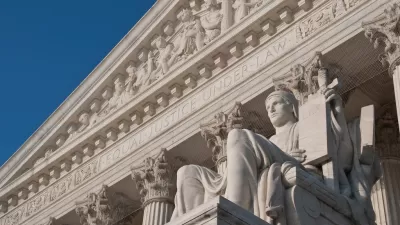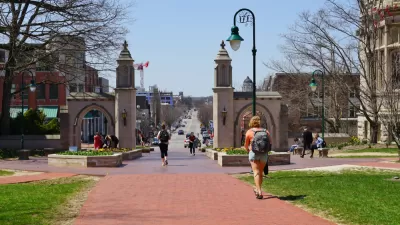A timely piece in The Guardian's City series looks at the demise of streetcars in Los Angeles, beginning with the Great American Streetcar Conspiracy. If only it was that simple.

With residents of Los Angeles County likely to vote this November on one of the largest local transportation tax measures in the history of the United States, with about one-third of the $120 billion sales tax measure to provide "full or partial funding for five new transit lines and at least six extensions of lines that are already built or under construction," it may be helpful to take another look back in time to understand the reasons for the demise of what was once the world's largest streetcar network.
"Why had American mass transit, especially the streetcars that were once the envy of the world, been so thoroughly dismantled?" asks Brian Ladd in Autophobia: Love and Hate in the Automotive Age. "How could Americans have been so shortsighted?”
Americans love a good conspiracy story, and when "the Federal District Court of Southern California in 1947 indicted nine corporations and seven individuals on counts of 'conspiring to acquire control of a number of transit companies, forming a transportation monopoly' and 'conspiring to monopolise sales of buses and supplies to companies owned by National City Lines' in violation of the 1890 Sherman Antitrust Act," writes Colin Marshall for The Guardian – Cities, what further proof is needed?
For the record, the case was appealed by National City Lines to the U.S. Supreme Court and decided in 1949, "with GM, Firestone, Standard Oil of California, Phillips Petroleum, and Mack Trucks found guilty and subsequently slapped on the wrists. (GM paid a fine of $5,000.)," adds Marshall.
"Although it's tempting to believe that evil forces must have been to blame, most historians agree that GM and the other mega-companies only helped to speed the end of the railway, which already was deep into red ink," wrote Cecilia Rasmussen for the Los Angeles Times in 2003.
"So why does the Great American Streetcar Scandal live on in the hearts and minds of Los Angeles?" asks Marshal.
"Angelenos are rightfully frustrated by being forced to buy cars and sit in traffic to get around, and many feel like this situation was foisted on them without the consent of residents,” says Ethan Elkind, author of Railtown: The Fight for the Los Angeles Metro Rail and the Future of the City, “It’s easy to blame car companies [e.g., General Motors] because they’re the logical economic beneficiary of this car-oriented system. But the reality is more complex, and if there’s any conspiracy here, it’s on the part of local officials who kept approving sprawling subdivisions that have led to the present inefficient land use patterns.”
Sprawling land use patterns undermined the Pacific Electric Railway and the irony is that it was the head of the new railway company, Henry E. Huntington, the nephew of railroad magnate Collis P. Huntington, who was responsible, according to Eric Molinsky in "The Great Red Car Conspiracy" (posted here.).
Huntington started building hundreds of subdivisions on the periphery of Los Angeles, and used Pacific Electric trains—bright red trolleys—to connect the subdivisions to downtown Los Angeles.
Over time, though, Huntington had built so many subdivisions that his Red Car couldn’t do a good enough job connecting the city’s disparate areas. The Red Car was never designed to be a comprehensive system like the New York City Subway; rather, it existed primarily to get people in and out of Huntington’s subdivisions. Angelenos who could afford cars found it was easier to get around by driving. The Red Car fell into disrepair, and was mocked as a “slum on wheels.”
The point at this look back in history is to recognize how important land use patterns are to transit. Constructing more rail lines needs to be accompanied by increased density at the rail stations to make rail more attractive than personal vehicles if the investment is going to succeed in the long term.
The Guardian – Cities series is supported by The Rockefeller Foundation.
FULL STORY: Story of cities #29: Los Angeles and the 'great American streetcar scandal'

Trump Administration Could Effectively End Housing Voucher Program
Federal officials are eyeing major cuts to the Section 8 program that helps millions of low-income households pay rent.

Planetizen Federal Action Tracker
A weekly monitor of how Trump’s orders and actions are impacting planners and planning in America.

Ken Jennings Launches Transit Web Series
The Jeopardy champ wants you to ride public transit.

Crime Continues to Drop on Philly, San Francisco Transit Systems
SEPTA and BART both saw significant declines in violent crime in the first quarter of 2025.

How South LA Green Spaces Power Community Health and Hope
Green spaces like South L.A. Wetlands Park are helping South Los Angeles residents promote healthy lifestyles, build community, and advocate for improvements that reflect local needs in historically underserved neighborhoods.

Sacramento Plans ‘Quick-Build’ Road Safety Projects
The city wants to accelerate small-scale safety improvements that use low-cost equipment to make an impact at dangerous intersections.
Urban Design for Planners 1: Software Tools
This six-course series explores essential urban design concepts using open source software and equips planners with the tools they need to participate fully in the urban design process.
Planning for Universal Design
Learn the tools for implementing Universal Design in planning regulations.
Heyer Gruel & Associates PA
Ada County Highway District
Institute for Housing and Urban Development Studies (IHS)
City of Grandview
Harvard GSD Executive Education
Toledo-Lucas County Plan Commissions
Salt Lake City
NYU Wagner Graduate School of Public Service




























